Baby feed routine
Tips for the First Year
Eat, sleep, pee, poop, repeat. Those are the highlights in a day of the life of a brand new baby.
And if you’re a new parent, it’s the eating part that may be the source of many of your questions and worries. How many ounces should your baby take? Do you wake a sleeping baby to eat? Why do they seem hungry all the time? When can your child start solids?
Questions abound — and, despite Grandma’s insistence, the answers have changed since you were a tot. It’s now recommended that newborns, even formula-fed ones, eat on demand (consider it good preparation for the teenage years) and that babies wait to start solid foods until they’re 4 to 6 months old.
On day one of life, your baby’s stomach is the size of a marble and can only hold 1 to 1.4 teaspoons of liquid at a time. As your baby gets older, their stomach stretches and grows.
It’s hard (or impossible, really) to know how much milk your baby is taking in while breastfeeding. But if you’re bottle feeding due to any number of valid reasons, it’s a bit easier to measure.
Here, from the American Academy of Pediatrics (AAP), a typical feeding schedule for bottle-fed babies.
| Age | Ounces per feeding | Solid foods |
|---|---|---|
| Up to 2 weeks of life | .5 oz. in the first days, then 1–3 oz. | No |
| 2 weeks to 2 months | 2–4 oz. | No |
| 2–4 months | 4-6 oz. | No |
| 4–6 months | 4–8 oz. | Possibly, if your baby can hold their head up and is at least 13 pounds. But you don’t need to introduce solid foods yet. |
| 6–12 months | 8 oz. | Yes. Start with soft foods, like one-grain cereals and pureed vegetables, meats, and fruits, progressing to mashed and well-chopped finger foods. Give your baby one new food at a time. Continue supplementing with breast or formula feedings. |
Every baby is unique — but one thing that’s pretty consistent is that breastfed babies eat more frequently than bottle-fed ones. That’s because breast milk is easily digested and empties from the stomach a lot quicker than formula.
Breastfed babies
There’s no rest for the weary. According to La Leche League International, you should begin nursing your baby within 1 hour of birth and provide about 8 to 12 feedings daily in the first few weeks of life (yeah, we’re exhausted for you).
At first, it’s important not to let your baby go more than 4 hours without feeding. You’ll likely need to wake them up if necessary, at least until breastfeeding is well established and they’re gaining weight appropriately.
As your baby grows and your milk supply amps up, your baby will be able to take in more milk in less time at one feeding. That’s when you might start to notice a more predictable pattern.
- 1 to 3 months: Your baby will feed 7 to 9 times per 24 hours.
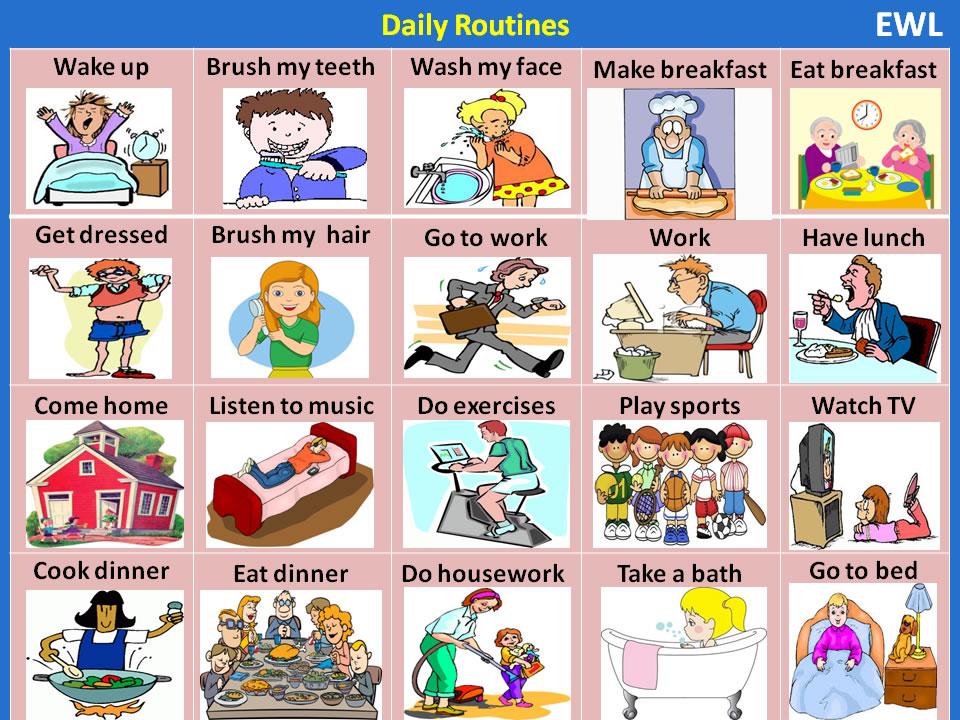
- 3 months: Feedings take place 6 to 8 times in 24 hours.
- 6 months: Your baby will feed around 6 times a day.
- 12 months: Nursing may drop to about 4 times a day. The introduction of solids at about 6 months helps to fuel your baby’s additional nutritional needs.
Keep in mind that this pattern is just one example. Different babies have different paces and preferences, along with other factors that influence the frequency of feedings.
Bottle-fed babies
Like breastfed babies, bottle-fed newborns should eat on demand. On average, that’s about every 2 to 3 hours. A typical feeding schedule may look like this:
- Newborn: every 2 to 3 hours
- At 2 months: every 3 to 4 hours
- At 4 to 6 months: every 4 to 5 hours
- At 6+ months: every 4 to 5 hours
For both breastfed and bottle-fed babies
- Don’t give liquids other than formula or breast milk to babies under a year old. That includes juices and cow’s milk.
 They don’t provide the right (if any) nutrients and can be upsetting to your baby’s tummy. Water can be introduced around 6 months when you start offering a cup.
They don’t provide the right (if any) nutrients and can be upsetting to your baby’s tummy. Water can be introduced around 6 months when you start offering a cup. - Don’t add baby cereal to a bottle.
- It can create a choking hazard.
- A baby’s digestive system isn’t mature enough to handle cereal until about 4 to 6 months of age.
- You could overfeed your baby.
- Don’t give your baby any form of honey until after their first birthday. Honey can be dangerous for a baby, occasionally causing what’s called infant botulism.
- Do adjust your expectations based on your baby and their unique needs. Premature babies are likely to follow feeding patterns according to their adjusted age. If your baby has challenges like reflux or failure to thrive, you may need to work with your doctor on the appropriate feeding schedule and amount they should be eating.
Schedules are the holy grail of every parent. Your child will naturally start to fall into a feeding pattern as their tummy grows and they can take in more breast milk or formula at one sitting. This may begin to happen between 2 and 4 months of age.
This may begin to happen between 2 and 4 months of age.
For now, though, focus on learning your baby’s hunger cues, such as:
- rooting around your chest, looking for a nipple.
- putting their fist in their mouth
- smacking or licking their lips
- fussing that can escalate quickly (don’t wait until your baby’s hangry to feed them)
Once your baby is a few months old, you may be able to introduce a sleep/feed schedule that works for you.
Let’s say, for example, your 4-month-old wakes every 5 hours for a feeding. That means if you feed at 9 p.m., your baby wakes around 2 a.m. But if you wake and feed the baby at 11 p.m., just before you go to bed, they may not rouse until 4 a.m., giving you a decent chunk of nighttime winks.
In general, if your baby seems hungry, feed them. Your baby will naturally eat more frequently during growth spurts, which typically occur around 3 weeks, 3 months, and 6 months of age.
Some babies will also “cluster feed,” meaning they’ll feed more frequently during certain periods and less at others. For example, your baby may cluster feed during the late afternoon and evening and then sleep longer at night (yay!). This is more common in breastfed babies than bottle fed babies.
For example, your baby may cluster feed during the late afternoon and evening and then sleep longer at night (yay!). This is more common in breastfed babies than bottle fed babies.
Worried about overfeeding? While this isn’t really possible to do with an exclusively breastfed baby, you can overfeed a baby who’s taking a bottle — especially if they’re sucking on the bottle for comfort. Follow their hunger cues, but talk to your pediatrician if you’re worried your little one may be overeating.
Your baby is probably ready for solids if they’re 4 to 6 months old and:
- have good head control
- seem interested in what you’re eating
- reach for food
- weigh 13 or more pounds
Which food to start with? The AAP now says it doesn’t really matter much in what order you introduce foods. The only real rule: Stick with one food for 3 to 5 days before offering another. If there’s an allergic reaction (rash, diarrhea, vomiting are common first signs), you’ll know which food is causing it.
As your baby grows, move from pureed baby food to ones that have more texture (for example, mashed banana, scrambled egg, or well-cooked, chopped pasta). This generally happens around 8 to 10 months of age.
Your supermarket offers a variety of baby food products, but if you want to make your own, keep it sugar and salt free. Additionally, at this stage, don’t feed your baby anything that could be a choking hazard, including:
- hard foods, such as popcorn or nuts
- hard, fresh fruits, like apples; cook to soften or chop into very small pieces
- any meat that isn’t well cooked and very well chopped (this includes hot dogs)
- cheese cubes
- peanut butter (though talk to your pediatrician about this one — and the benefits of introducing diluted peanut butter before the age of 1)
As your baby nears their first birthday, they should be eating a variety of foods and taking in about 4 ounces of solids at each meal. Continue to offer breast milk or formula. By 8 months, babies are drinking about 30 ounces a day.
By 8 months, babies are drinking about 30 ounces a day.
Oh yeah, and buy some stock in a company that makes stain-fighting laundry detergent. It’ll pay for college.
Babies aren’t cookie cutter. Some will gain weight easily, while others will have problems. Things that can affect a baby’s weight gain include:
- having a birth defect like a cleft lip or palate, which creates problems feeding
- having a milk protein intolerance
- being premature
- being fed with a bottle versus the breast
A 2012 study of more than 1,800 babies found that the infants who were fed with a bottle — regardless of whether the bottle contained breast milk or formula — gained more weight in the first year than babies who nursed exclusively.
Your baby’s doctor is the best one to advise you on a healthy weight range for your baby.
How, when, and what to feed a baby are top worries of every parent — but there’s good news: Most babies are pretty good judges of when they’re hungry and when they’re full — and they’ll let you know it.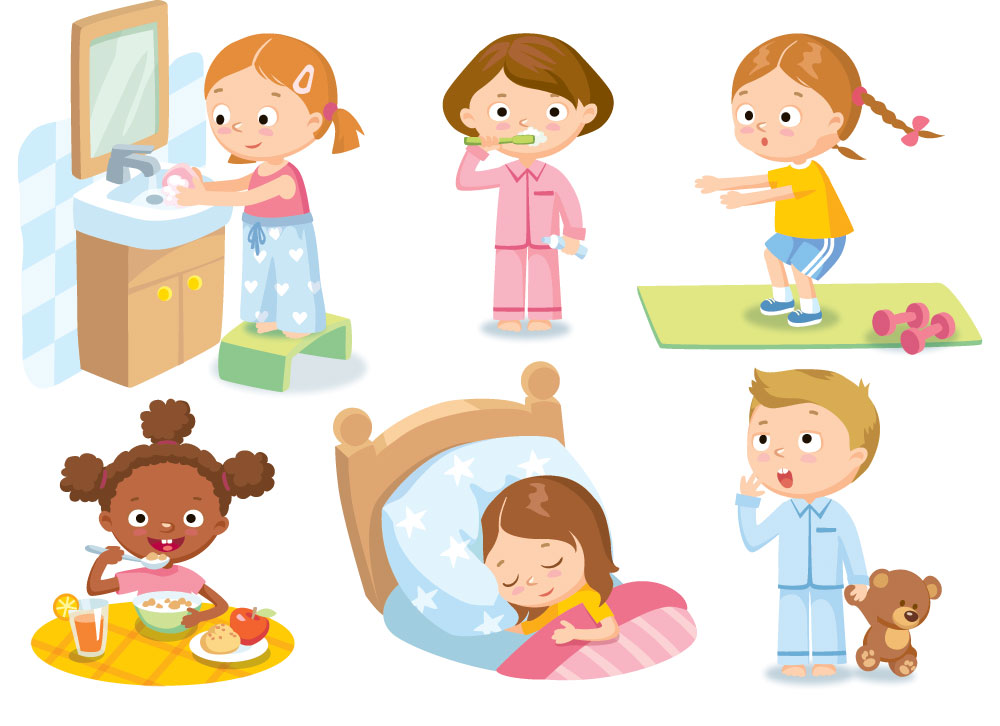
You just need to present them with the right choices at the right time and pay attention to their cues. If you have any questions or concerns, your pediatrician is there to help you along the way.
Tips for the First Year
Eat, sleep, pee, poop, repeat. Those are the highlights in a day of the life of a brand new baby.
And if you’re a new parent, it’s the eating part that may be the source of many of your questions and worries. How many ounces should your baby take? Do you wake a sleeping baby to eat? Why do they seem hungry all the time? When can your child start solids?
Questions abound — and, despite Grandma’s insistence, the answers have changed since you were a tot. It’s now recommended that newborns, even formula-fed ones, eat on demand (consider it good preparation for the teenage years) and that babies wait to start solid foods until they’re 4 to 6 months old.
On day one of life, your baby’s stomach is the size of a marble and can only hold 1 to 1.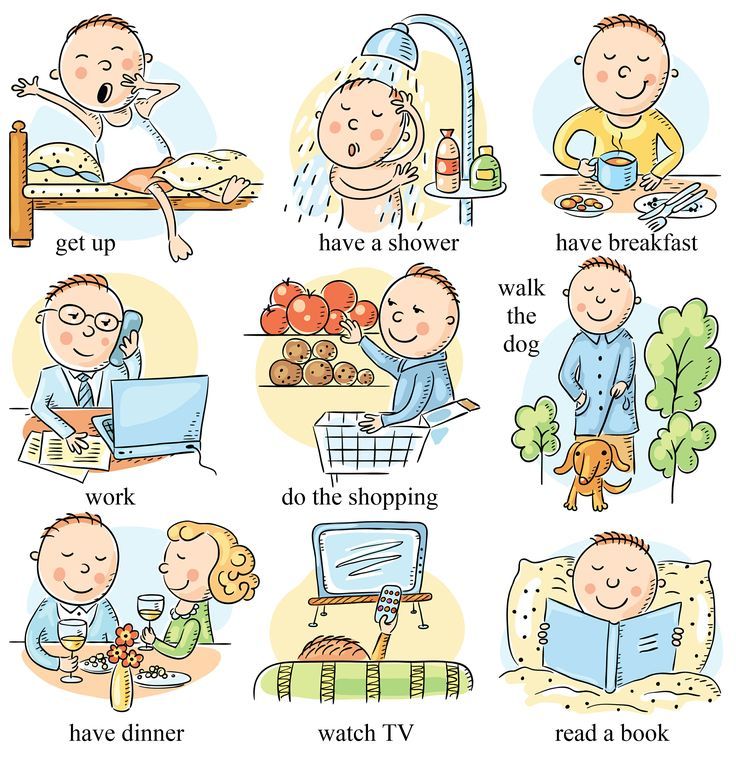 4 teaspoons of liquid at a time. As your baby gets older, their stomach stretches and grows.
4 teaspoons of liquid at a time. As your baby gets older, their stomach stretches and grows.
It’s hard (or impossible, really) to know how much milk your baby is taking in while breastfeeding. But if you’re bottle feeding due to any number of valid reasons, it’s a bit easier to measure.
Here, from the American Academy of Pediatrics (AAP), a typical feeding schedule for bottle-fed babies.
| Age | Ounces per feeding | Solid foods |
|---|---|---|
| Up to 2 weeks of life | .5 oz. in the first days, then 1–3 oz. | No |
| 2 weeks to 2 months | 2–4 oz. | No |
| 2–4 months | 4-6 oz. | No |
| 4–6 months | 4–8 oz. | Possibly, if your baby can hold their head up and is at least 13 pounds. But you don’t need to introduce solid foods yet. |
| 6–12 months | 8 oz. | Yes. Start with soft foods, like one-grain cereals and pureed vegetables, meats, and fruits, progressing to mashed and well-chopped finger foods.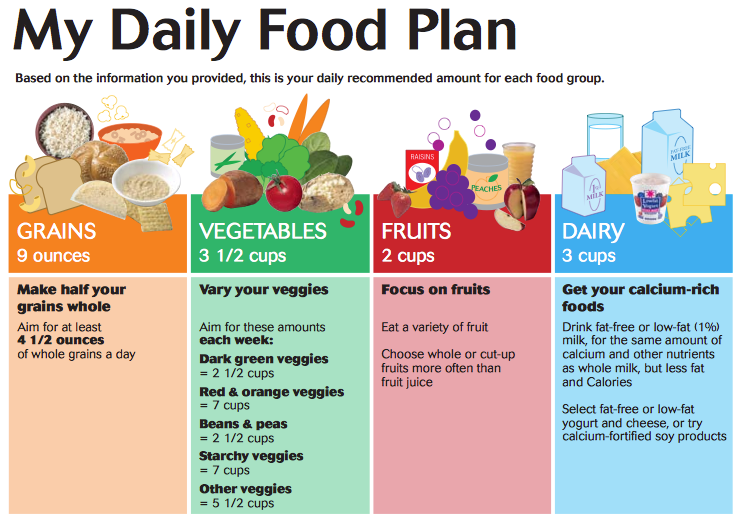 Give your baby one new food at a time. Continue supplementing with breast or formula feedings. Give your baby one new food at a time. Continue supplementing with breast or formula feedings. |
Every baby is unique — but one thing that’s pretty consistent is that breastfed babies eat more frequently than bottle-fed ones. That’s because breast milk is easily digested and empties from the stomach a lot quicker than formula.
Breastfed babies
There’s no rest for the weary. According to La Leche League International, you should begin nursing your baby within 1 hour of birth and provide about 8 to 12 feedings daily in the first few weeks of life (yeah, we’re exhausted for you).
At first, it’s important not to let your baby go more than 4 hours without feeding. You’ll likely need to wake them up if necessary, at least until breastfeeding is well established and they’re gaining weight appropriately.
As your baby grows and your milk supply amps up, your baby will be able to take in more milk in less time at one feeding. That’s when you might start to notice a more predictable pattern.
- 1 to 3 months: Your baby will feed 7 to 9 times per 24 hours.
- 3 months: Feedings take place 6 to 8 times in 24 hours.
- 6 months: Your baby will feed around 6 times a day.
- 12 months: Nursing may drop to about 4 times a day. The introduction of solids at about 6 months helps to fuel your baby’s additional nutritional needs.
Keep in mind that this pattern is just one example. Different babies have different paces and preferences, along with other factors that influence the frequency of feedings.
Bottle-fed babies
Like breastfed babies, bottle-fed newborns should eat on demand. On average, that’s about every 2 to 3 hours. A typical feeding schedule may look like this:
- Newborn: every 2 to 3 hours
- At 2 months: every 3 to 4 hours
- At 4 to 6 months: every 4 to 5 hours
- At 6+ months: every 4 to 5 hours
For both breastfed and bottle-fed babies
- Don’t give liquids other than formula or breast milk to babies under a year old.
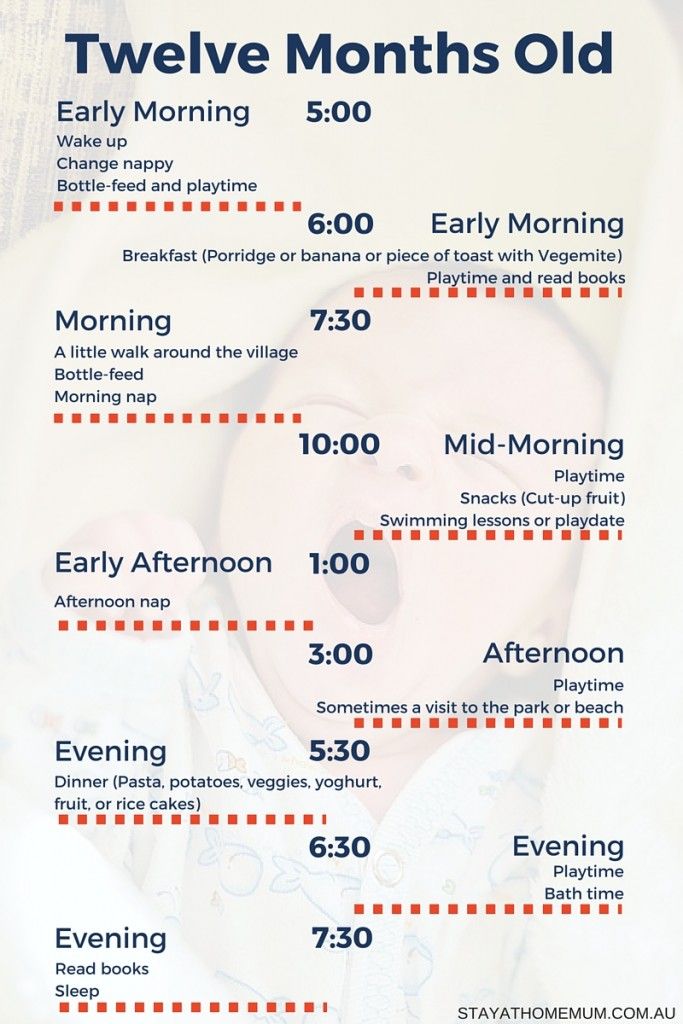 That includes juices and cow’s milk. They don’t provide the right (if any) nutrients and can be upsetting to your baby’s tummy. Water can be introduced around 6 months when you start offering a cup.
That includes juices and cow’s milk. They don’t provide the right (if any) nutrients and can be upsetting to your baby’s tummy. Water can be introduced around 6 months when you start offering a cup. - Don’t add baby cereal to a bottle.
- It can create a choking hazard.
- A baby’s digestive system isn’t mature enough to handle cereal until about 4 to 6 months of age.
- You could overfeed your baby.
- Don’t give your baby any form of honey until after their first birthday. Honey can be dangerous for a baby, occasionally causing what’s called infant botulism.
- Do adjust your expectations based on your baby and their unique needs. Premature babies are likely to follow feeding patterns according to their adjusted age. If your baby has challenges like reflux or failure to thrive, you may need to work with your doctor on the appropriate feeding schedule and amount they should be eating.
Schedules are the holy grail of every parent. Your child will naturally start to fall into a feeding pattern as their tummy grows and they can take in more breast milk or formula at one sitting.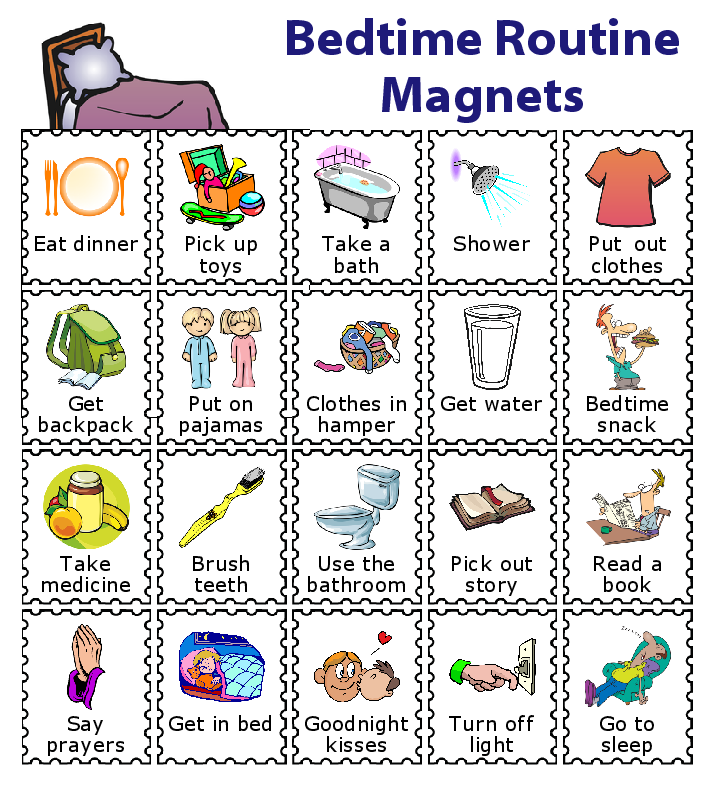 This may begin to happen between 2 and 4 months of age.
This may begin to happen between 2 and 4 months of age.
For now, though, focus on learning your baby’s hunger cues, such as:
- rooting around your chest, looking for a nipple.
- putting their fist in their mouth
- smacking or licking their lips
- fussing that can escalate quickly (don’t wait until your baby’s hangry to feed them)
Once your baby is a few months old, you may be able to introduce a sleep/feed schedule that works for you.
Let’s say, for example, your 4-month-old wakes every 5 hours for a feeding. That means if you feed at 9 p.m., your baby wakes around 2 a.m. But if you wake and feed the baby at 11 p.m., just before you go to bed, they may not rouse until 4 a.m., giving you a decent chunk of nighttime winks.
In general, if your baby seems hungry, feed them. Your baby will naturally eat more frequently during growth spurts, which typically occur around 3 weeks, 3 months, and 6 months of age.
Some babies will also “cluster feed,” meaning they’ll feed more frequently during certain periods and less at others.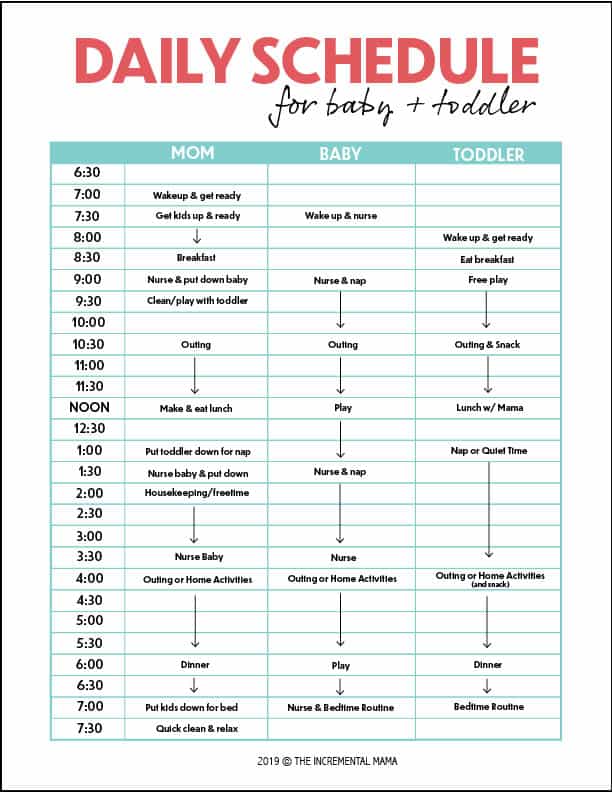 For example, your baby may cluster feed during the late afternoon and evening and then sleep longer at night (yay!). This is more common in breastfed babies than bottle fed babies.
For example, your baby may cluster feed during the late afternoon and evening and then sleep longer at night (yay!). This is more common in breastfed babies than bottle fed babies.
Worried about overfeeding? While this isn’t really possible to do with an exclusively breastfed baby, you can overfeed a baby who’s taking a bottle — especially if they’re sucking on the bottle for comfort. Follow their hunger cues, but talk to your pediatrician if you’re worried your little one may be overeating.
Your baby is probably ready for solids if they’re 4 to 6 months old and:
- have good head control
- seem interested in what you’re eating
- reach for food
- weigh 13 or more pounds
Which food to start with? The AAP now says it doesn’t really matter much in what order you introduce foods. The only real rule: Stick with one food for 3 to 5 days before offering another. If there’s an allergic reaction (rash, diarrhea, vomiting are common first signs), you’ll know which food is causing it.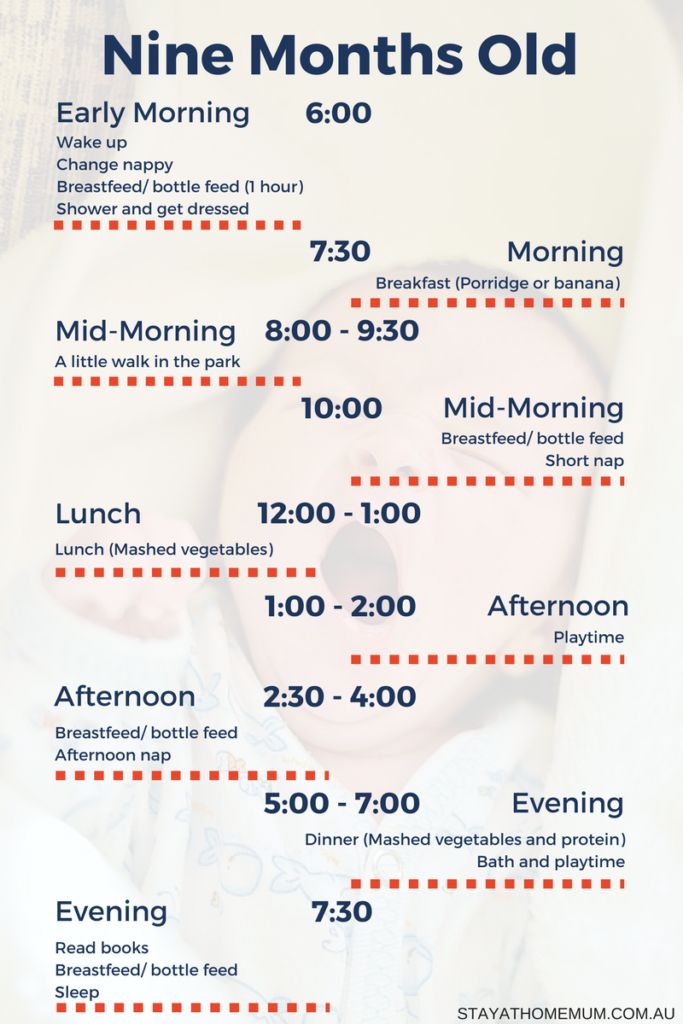
As your baby grows, move from pureed baby food to ones that have more texture (for example, mashed banana, scrambled egg, or well-cooked, chopped pasta). This generally happens around 8 to 10 months of age.
Your supermarket offers a variety of baby food products, but if you want to make your own, keep it sugar and salt free. Additionally, at this stage, don’t feed your baby anything that could be a choking hazard, including:
- hard foods, such as popcorn or nuts
- hard, fresh fruits, like apples; cook to soften or chop into very small pieces
- any meat that isn’t well cooked and very well chopped (this includes hot dogs)
- cheese cubes
- peanut butter (though talk to your pediatrician about this one — and the benefits of introducing diluted peanut butter before the age of 1)
As your baby nears their first birthday, they should be eating a variety of foods and taking in about 4 ounces of solids at each meal. Continue to offer breast milk or formula. By 8 months, babies are drinking about 30 ounces a day.
By 8 months, babies are drinking about 30 ounces a day.
Oh yeah, and buy some stock in a company that makes stain-fighting laundry detergent. It’ll pay for college.
Babies aren’t cookie cutter. Some will gain weight easily, while others will have problems. Things that can affect a baby’s weight gain include:
- having a birth defect like a cleft lip or palate, which creates problems feeding
- having a milk protein intolerance
- being premature
- being fed with a bottle versus the breast
A 2012 study of more than 1,800 babies found that the infants who were fed with a bottle — regardless of whether the bottle contained breast milk or formula — gained more weight in the first year than babies who nursed exclusively.
Your baby’s doctor is the best one to advise you on a healthy weight range for your baby.
How, when, and what to feed a baby are top worries of every parent — but there’s good news: Most babies are pretty good judges of when they’re hungry and when they’re full — and they’ll let you know it.
You just need to present them with the right choices at the right time and pay attention to their cues. If you have any questions or concerns, your pediatrician is there to help you along the way.
Daily routine for a child under 1 year old
Daily routine is a system for distributing periods of sleep and wakefulness, meals, hygiene and health procedures, activities and independent human activities throughout the day.
Compliance with a rational daily routine corresponding to the age characteristics of the child contributes to his healthy growth and development. Getting used to performing various types of activities at the same time, the child is prepared for the upcoming type of activity at every moment of time, which ensures their easier and faster implementation. Compliance with the correct daily routine provides a good mood for the child and maintains a keen interest in the study of the world around him, contributing to his normal motor and psychoverbal development. nine0003
nine0003
The child's daily routine includes the following obligatory elements: diet, time spent outdoors during the day, frequency and duration of sleep, mandatory classes to develop skills in accordance with age, free time.
In the first months after birth, a healthy newborn baby sleeps for most of the day, since all external stimuli are very strong for the nervous system of a child, accustomed to a cozy intrauterine environment, and cause its rapid exhaustion. As the child grows older, the duration of sleep gradually decreases and the time of wakefulness increases. nine0003
| Age | Daytime sleep mode | Night sleep | Wake mode |
| From birth to 2 months | 6 x 2.5 hours | 6 hours | During feeding |
| 2-4 months | 5 times 2-2.5 hours | 6.5 hours | 4 x 1.5 hours |
| 4-6 months | 4-5 times for 2 hours | 7 hours | nine0013 4 times 2 hours|
| 6-9 months | 3-4 times for 1. 5-2 hours 5-2 hours | 8 hours | 4 x 2.5 hours |
| 9-12 months | 2 x 1.5-2 hours | 9-10 hours | 4 times for 3-4 hours |
Closely related to the sleep-wake mode is the feeding mode of the baby. The sleep of a child in the first months of life is very sensitive and is easily disturbed under the influence of various extraneous stimuli, including hunger. nine0003
| Age | Mode | Example |
| From birth to 2 months | 7-8 times, every 3 hours | 6,9,12,15,18,21,24 (no night feeding) |
| From 2 to 6 months | 6-7 times, every 3.5 hours | 6, 9.30, 13, 16.30, 20, 23.30 (without night feeding) 6, 9.30, 13, 16.30, 20, 23.30, 03 (with night feeding) |
| From 7-12 months | 5 times, every 4 hours | 6,10,14,18,22 |
A child's stay in the fresh air is essential in the daily routine. The total duration of stay in the open air for children under 1 year of age should be at least 5-6 hours a day. Fresh air has a calming effect on the baby, improves metabolic processes, and increases the body's defenses. In the summer, all games and activities should be held outdoors; in the cold and transitional seasons, two one-time walks of 1.5-2 hours are provided. nine0003
The total duration of stay in the open air for children under 1 year of age should be at least 5-6 hours a day. Fresh air has a calming effect on the baby, improves metabolic processes, and increases the body's defenses. In the summer, all games and activities should be held outdoors; in the cold and transitional seasons, two one-time walks of 1.5-2 hours are provided. nine0003
Fresh air also has a beneficial effect on sleep. By acting on the skin and mucous membranes of the nose and upper respiratory tract, it provides a faster fall asleep of the child and a higher quality of sleep. Sleeping outside can replace a walk, especially during the cold season.
The child's daily routine is generally individual, but ideally, one should strive to ensure that the child eats after waking up, and then stays awake until the next sleep. A well-slept baby eats with appetite and then calmly and actively plays or engages, and tired of games, easily goes to sleep. nine0003
When your baby is awake, try to keep him active and cheerful. It is necessary to dress the child in loose clothing that does not hinder movement, provide access to toys appropriate for his age, and most importantly, actively participate in games and activities with the baby as a whole family.
It is necessary to dress the child in loose clothing that does not hinder movement, provide access to toys appropriate for his age, and most importantly, actively participate in games and activities with the baby as a whole family.
Author - Physiotherapist - DMITRIENKO T.G.
A child's daily routine up to the year
"There is nothing worse than the unknown" - this expression is true for parents and for children. Even if now it seems to you that there is nothing more boring than following a daily routine, you should know:
- daily routine makes parenthood easier - you can plan things, get help and make time for your rest;
- thanks to the predictable order of actions, parents experience less stress and fatigue;
- children love the routine, they are calmed by predictability - a certain order gives children a sense of security, reduces stress;
- daily routine strengthens the child's nervous system and metabolic processes;
- the mode allows you to set the work of the "internal clock of the body"; nine0003
- mode is the most effective tool for improving sleep.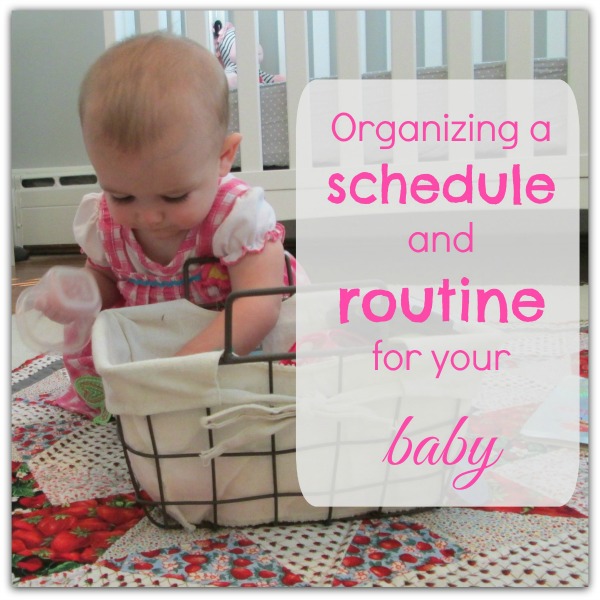
Researchers found that 72% of children aged 0 to 5 with a regular sleep ritual went to bed earlier, fell asleep faster, woke up less often, had longer sleep duration*
How does the child's routine change?
A baby's daily routine changes several times during the first year of life. The baby is born with an undeveloped chaotic sleep, does not distinguish between day and night. We are not talking about the daily routine by the clock, the child lives in his own rhythm of sleep and wakefulness. Gradually, the baby grows, his nervous system and endurance are getting stronger, he can withstand long periods of time without overwork. The structure of a child's sleep is changing, becoming more and more like an adult's sleep. nine0003
Wake time grows with your baby.
- Children spend 2/3 of their time sleeping with several periods of sleep and wakefulness. The sleep cycle lasts approximately 40-50 minutes (depending on age) and repeats cyclically.
- Between the 3rd and 4th month of a child's life, circadian rhythms are formed. The baby begins to respond to light / dark, external signals (for example, rituals), which helps him to distinguish between sleep and wakefulness.
- It is during this period that sleep consolidates around the night - children sleep more at night and less during the day; the first glimpses of the regime of the day by the hour are formed. nine0003
As the child grows, the amount of nighttime sleep increases and the amount of daytime sleep decreases:
- Newborns: 4-6 naps
- 6-9 months: 3 naps
- 1 month - 5 months
- 15/18 months - 4 years: 1 nap
For your convenience, all the most important moments at each age, we have put in the table:
| Age | SLEEP: important moments in every age |
| 0-3 months | - no regime, babies live in feeding regime - establishment of breastfeeding - priority - it is more convenient to put it down when the mother herself goes to bed (at 22-23:00) |
| 3-4 months | - a "window of sleep" appears, it is worth fixing the time of nightly bedtime - daytime naps remain "unorganized" |
| 4-5 months | - night sleep is stabilizing - bedtime and wake-up time - morning sleep is recorded - 1. |
| 5-6 months | - the first mode, the start time of night sleep in the interval 19:00 - 20:30 - daytime sleep is stabilizing |
| 6-8 months | - follow the daily routine, monitor the sleep conditions - for breastfed and formula-fed babies, separate food and sleep |
| 9-12 months | - refusal of the 3rd daytime sleep is possible, refusal of night feedings - peak of separation from mother + mastering new skills disturbs sleep |
| 1-2.5 years | - 2 naps are consolidated into 1 nap, nap time remains the same - all food offered before brushing teeth - eating in bed is a bad habit! |
How to start building a regime?
All babies are different - with different temperament, pace of development, health characteristics and individual need for sleep.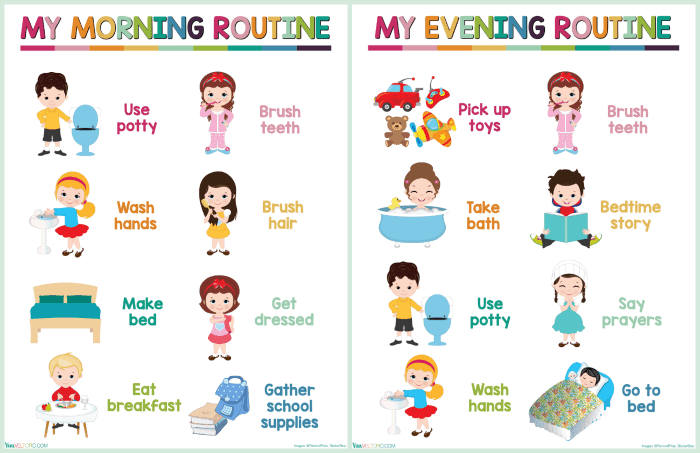 That is why the norms of sleep and wakefulness have such wide boundaries, and the daily routine, which is ideal for one baby, will not work at all for another.
That is why the norms of sleep and wakefulness have such wide boundaries, and the daily routine, which is ideal for one baby, will not work at all for another.
nine0002 The task of parents is to be observant and choose exactly the mode that will suit your child. Do not forget to change the mode when the baby grows out of it
But how to build a routine that is right for your child? We suggest not to rush, not to adjust the child to the tables, but to act gradually and thoughtfully.
Below are 6 simple steps to help you build a comfortable daily routine for your child.
1. Keep records. nine0182
. In a series of similar days and without records, it is difficult to remember how much your child slept, what time he ate or fell asleep, how often he woke up.
Recordings will allow you to better analyze the situation, understand whether the child is getting enough sleep, monitor progress, share your observations with a doctor or sleep consultant. nine0003
nine0003
For several days, write down in detail all the important moments of your child's day:
- wake up time in the morning
- bedtime including all bedtime rituals
- how long does it take for baby to fall asleep
- start time and duration of daytime and nighttime sleep
- number of awakenings
- as well as other events of the day: feeding, walking, playing, going to the toilet, crying.
nine0002 VIDEO TUTORIALS
Baby Sleep Lessons
0-7 years old
More
2. Record the time you get up in the morning.
Getting ready for a good night's sleep is important in the morning. To make the night perfect, start preparing at sunrise!
The best time to start the day is between 6:00 am and 7:30 am. If the baby sleeps too long in the morning, this will negatively affect the entire alignment of the day, as well as the time of departure for a night's sleep.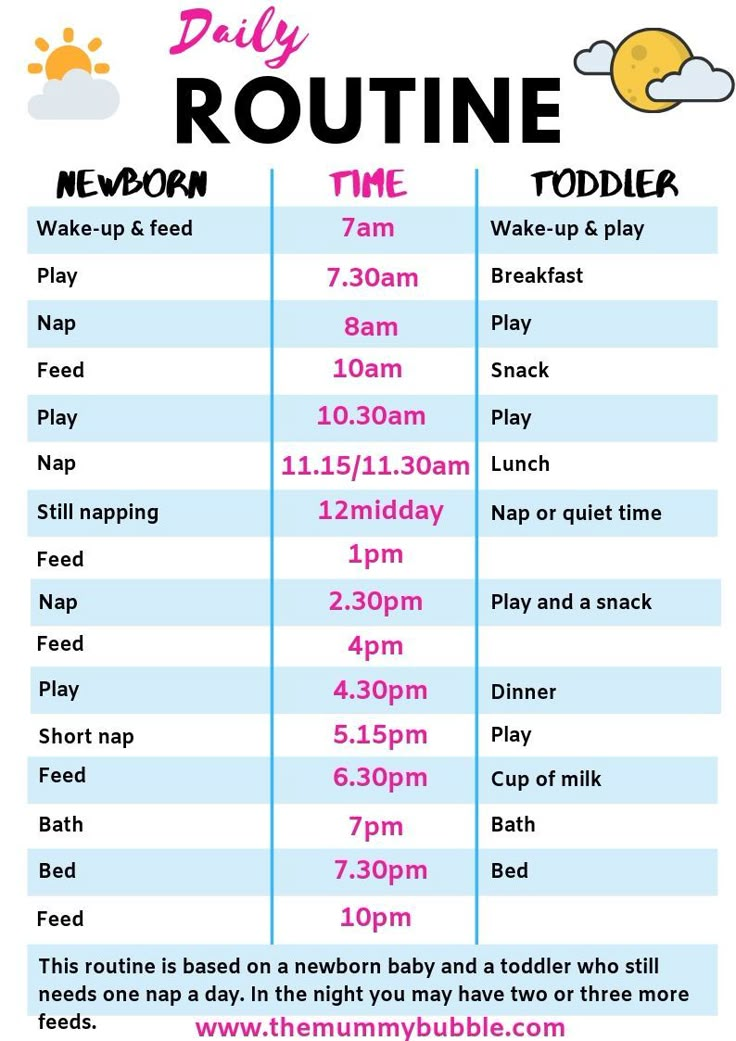 As terrible as it sounds, wake your child up if they are sleeping after 7:30 in the morning. Please note that wake-ups before 6:00 am are considered too early. If the baby wakes up too early in the morning, this is a signal that the proposed regimen does not suit him, and there is not enough sleep. nine0003
As terrible as it sounds, wake your child up if they are sleeping after 7:30 in the morning. Please note that wake-ups before 6:00 am are considered too early. If the baby wakes up too early in the morning, this is a signal that the proposed regimen does not suit him, and there is not enough sleep. nine0003
3. Keep track of your wake time.
Find out how much wake time (WB) your child has. This knowledge helps to build the regime correctly and not to miss the signs of fatigue, carried away by business.
Understanding the minimum, comfortable and maximum awake time helps to effectively plan the time of the parents, or at least understand how much time is available from one nap to another.
For example, a mother knows that the child will need to be put to bed in 10 minutes, she will not start preparing a complex dish that requires her attention.
Knowing how long your baby goes awake helps you better recognize your baby's signals. Especially if he does not show signs of fatigue well or the mother has not yet learned to understand these signs.
Especially if he does not show signs of fatigue well or the mother has not yet learned to understand these signs.
It is important to check the wake time every 2-3 weeks and adjust the regimen. Ask yourself every few weeks “has my baby grown up, has his WB changed?” nine0003
If we look at the table of wakefulness norms, we will see that the boundaries of norms are quite wide. Remember that the time of wakefulness throughout the day is unevenly distributed - the shortest WB before morning sleep, the longest WB before night.
For your convenience, we have put all the most important moments at each age in the table:
| Focus on the lower limit of normal if: | Refer to the upper limit of normal if: |
| - the baby fits into the first daytime sleep, - the baby does not feel well, - the child had a very strenuous activity, - the baby had a short sleep, which could not be extended | - the baby is laid down for a night's sleep - the baby slept through a full daytime sleep (2 cycles) - the child is in good health nine0014 |
4.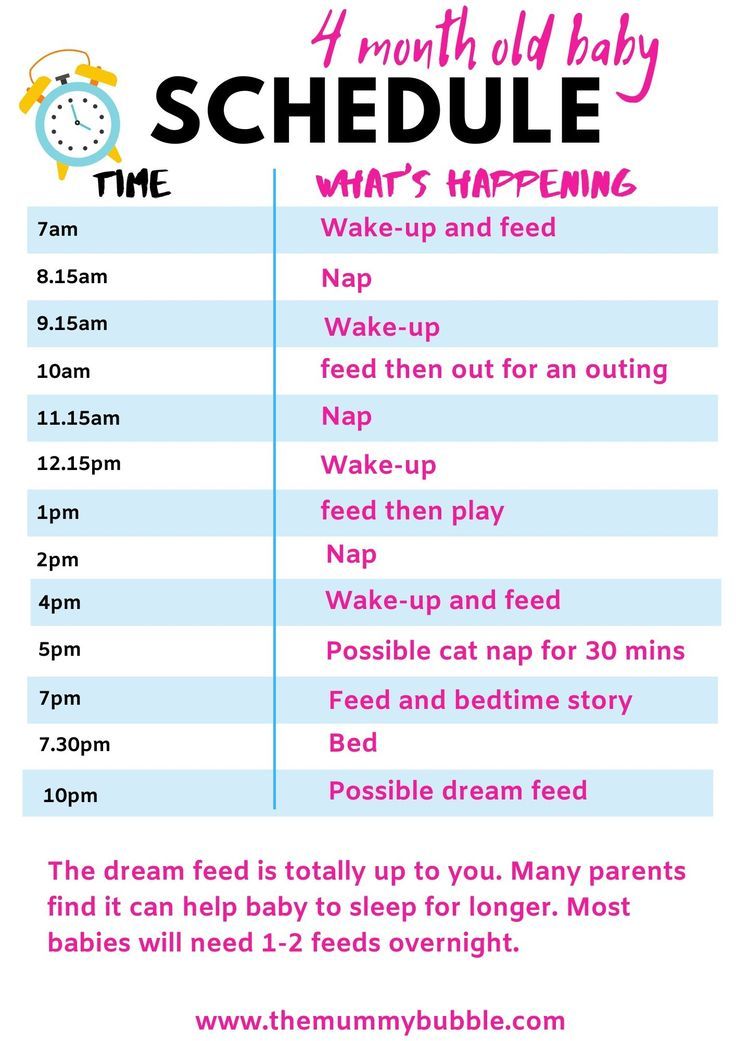 Form the correct wakefulness rhythm.
Form the correct wakefulness rhythm.
All your activities during the day are essential for quality daytime and nighttime sleep.
Go outside in the morning to give your child a daily dose of sunlight. This is necessary for the formation of circadian rhythms and the production of the "sleep hormone" melatonin.
It is important that the child is not too tired during the day. Severe overwork will harm sleep, and it is very difficult for an overexcited baby to calm down and fall asleep. But, at the same time, the baby needs to accumulate the “right” fatigue. nine0003
when when the child is awake, the correct sequence should be: 1) after sleep, choose an active activity, 2) then switch the child to quiet wakefulness, 3) conduct a ritual of preparation for sleep and 4) sleep.
Active wakefulness is not only physical activity, but also mental stress, learning new things, including new skills.
Examples of active wakefulness:
- walk,
- practicing any new skill (crawling, walking, finger painting, sorting or pyramiding),
- new people or people who rarely come,
- physical interaction with mother or other loved ones - tickling, squeezing, massage, gymnastics
- participation in "adult" household chores
How does staying awake affect sleep?
- Physical activity lengthens deep sleep
- working out new skills in the afternoon contributes to their fixation
- the child receives the necessary dose of sunlight and serotonin, which goes to melatonin in the dark
- physical activity “burns” stress hormones
Calm wakefulness it is any normal activity. For example, reading, sorting, transfusion, kinetic and ordinary sand, grits.
How does staying awake affect sleep?
- Gradually reduces muscle tension
- Creates predictability by reducing anxiety
- Emotional closeness and physical contact with the mother "satisfy" the need for contact, acceptance and strengthen attachment
- Switches to inner sensations more than to the world outside
A cool idea for a quiet wake is a sensory box.
A large box or bowl filled with sand, grains, balls and small items. Periodically change the contents of the box, the child can dig in it for a long time, shift objects, touch sand or grains. nine0003
5. Choose a time to prepare for sleep rituals.
In the evenings, any home is usually busy. The whole family is together, everyone wants to eat and communicate, noise and light. From this, the baby can be overexcited. And it will be difficult to put him to sleep. To avoid this, start getting ready for bed gradually, at least half an hour before bedtime:
- close the curtains, dim the lights throughout the house (turn on the bottom light in the house and dim lamp in the bedroom)
- turn off the music, TV, computer, put away the phone (in addition to noise, they also emit blue spectrum rays that are detrimental to melatonin)
- turn on "white noise" (recording, special device or toy with white noise)
- give a relaxing massage to your baby
- bathe him in a warm bath
- read a book, tell a story or sing a lullaby
These rituals will help your baby switch from wakefulness, relax and tune in to sleep. Use an abbreviated version of rituals before nap time. It is important that the ritual is liked not only by the baby, but also by the mother. nine0003
Use an abbreviated version of rituals before nap time. It is important that the ritual is liked not only by the baby, but also by the mother. nine0003
Even more ideas for bedtime rituals you will find in our ritual generator http://zasypalki.spimalysh.ru
6. Find the perfect time to go to bed for a night's sleep - "sleep window"
The "sleep hormone" accumulates in the blood in sufficient concentration to fall asleep, we call it the "sleep window". If you recognize the “sleep window” and put the baby to bed at this time, his sleep will be long and of high quality.
In most children, the "window of sleep" should be sought in the early evening, between 18:30 and 20:30 hours. It does not last long, 15-20 minutes. nine0003
From birth to 3/4 months: until the synthesis of own melatonin is established, the child can be laid down at 22-23:00.
Starting at 3/4 months: It is important to calculate your baby's "sleep window" and go to bed at that time, starting all bedtime preparations 30-40 minutes before this time.

 5 hours after waking up, 2 afternoon sleeps
5 hours after waking up, 2 afternoon sleeps 









